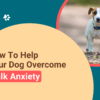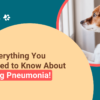
First Aid For Pets: Lifesaving Skills Every Owner Must Know – Essential Emergency Tips for Pet Safety & Care
Just like humans, our furry friends can encounter unexpected mishaps and emergencies at any time. Every day, pets around the globe find themselves in situations that require immediate attention, from accidental ingestion of hazardous substances to unexpected injuries.
In the United States alone, it is estimated that hundreds of thousands of pets experience a poisoning episode each year, signifying a crucial need for pet owners to be primed with first-aid knowledge.
In this article, we will delve into the basics of pet first aid, spotlighting practical tips and life-saving skills, ranging from handling common accidents to providing CPR, ensuring you’re always prepared to step in when your beloved companion needs you the most. Together, let’s create a safer world for our pawed pals.
Understanding The Basics
Preparation and Prevention
While we always hope to shield our beloved pets from harm’s way, the best armor is a blend of preparation and prevention. Regular vet check-ups are the cornerstone of this approach. Much like our annual doctor visits, these check-ups can detect potential health issues before they escalate, ensuring our pets remain in optimal health.
But prevention extends to our homes as well. Curious whiskers and wagging tails can easily find themselves entangled with hazards. From toxic foods to small, swallowable objects, it’s essential to pet-proof our living spaces and keep potential dangers out of paws’ reach.
Moreover, time is of the essence during emergencies. Having an emergency contact list readily accessible — including your primary veterinarian, the nearest emergency vet clinic, and poison control — can expedite crucial care and potentially save your pet’s life. In essence, being proactive today can prevent a crisis tomorrow.
Creating a Pet First Aid Kit
Within the day-to-day adventures of pet ownership, maintaining a robust first aid kit becomes a silent yet crucial task. The kit, bearing essentials like specially designed bandages, gauze, antiseptic wipes, cautious-use hydrogen peroxide, and tweezers, waits quietly, ready to aid in unexpected times.
Yet, every pet is a universe of unique needs and potential mishaps. A cat might need specific anti-hairball remedies, whereas an explorative dog may need extra help after tangling with outdoor critters. Thus, the first aid kit morphs beyond a standard checklist, reflecting your pet’s specific needs and adventures.
The placement of this kit is equally pivotal – accessibility in urgency cannot be overstated. In emergency situations, where every tick of the clock is crucial, having a well-stocked and easily reachable kit transforms into a vital shield, defending our pet’s health during those pulse-racing moments. With a well-made and well-placed first aid kit, we show we’re responsible pet owners, ready and able to handle sudden surprises and challenges.
Recognizing Emergencies
Common Signs
Understanding our pets’ signs of distress comes down to keen observation and swift action. It’s vital to know what to look for. Difficulty in breathing, for example, can be spotted through struggling inhalations or exaggerated movements of the chest, signaling a need for instant help. Unconsciousness, or a failure to respond to stimuli, is another immediate call to action.
Additionally, we can’t ignore explicit warnings like severe bleeding, whether visible externally or present in vomit or stool. Likewise, the sudden occurrence of seizures, displaying through spasms, uncontrolled movements, or a brief halt in mobility, signals a serious issue at hand.
As pet owners, our ability to adapt to and recognize these signs is crucial. Caring for our pets involves silently comprehending their needs and responding effectively, ensuring their health and joy are uninterrupted. This silent communication goes beyond words, creating a bond that connects humans and animals. And in times of crisis, our alert understanding can be the pivotal factor that ensures our pets get the urgent care they need.
Types of Emergencies
Emergencies come in various forms, and recognizing their nature is the first step towards effective intervention. Choking, for instance, is evident when a pet shows distress around its mouth or throat, perhaps pawing at its face or making gagging sounds, indicative of an obstructed airway. Trauma, on the other hand, often has more visible repercussions.
Events like being hit by a car can lead to external injuries, limping, or internal complications, warranting immediate medical attention. Poisoning, a silent adversary, manifests through symptoms like drooling, vomiting, lethargy, or sudden behavioral changes; it’s imperative to act quickly, especially if you suspect ingestion of toxic substances.
Lastly, burns, whether from a hot surface or chemical exposure, may lead to noticeable skin damage, pain, or discomfort in your pet. In each scenario, timely recognition and action are the keys to mitigating harm and ensuring your pet’s recovery.
Lifesaving First Aid Skills
CPR for Pets
In the most critical moments, when life hangs in the balance, CPR (Cardiopulmonary Resuscitation) becomes an indispensable skill for pet owners. It’s a beacon of hope in situations where every second counts.
First, ascertain if CPR is necessary by checking for a heartbeat and observing the pet’s breathing. Gently placing a hand or ear near the pet’s chest or feeling the pulse point inside the thigh can provide clues. If no signs of life are evident, promptly position the pet on its side on a firm surface.
For chest compressions, ensure that you’re pressing at a depth that’s proportionate to the size of the pet: roughly one-third to one-half the depth of the chest. Maintain a steady rhythm, and after every 30 compressions, give two rescue breaths by sealing the pet’s mouth and breathing into its nose.
It’s vital to note that CPR techniques can vary based on the type of pet. For instance, smaller dogs and cats might require more gentle compressions, while larger dogs might necessitate deeper pushes. Always educate yourself on the specific needs of your pet, and whenever possible, attend training to refine your CPR skills. It’s an investment in your pet’s safety and your peace of mind.
Handling Choking
A ball of yarn, a misplaced toy, or even a piece of food can quickly turn a playful moment into a perilous situation when a pet begins to choke. Recognizing the signs is paramount: distress sounds, pawing at the mouth, excessive drooling, and panicked movements are alarm bells indicating a possible obstruction in the throat.
If you suspect your pet is choking, approach with caution as panic can make even the gentlest animal lash out. Gently open their mouth to check for any visible obstructions. If you can safely remove the item without pushing it further down, do so.
For cases where the obstruction isn’t easily reachable, the Heimlich maneuver comes into play. For dogs, stand behind them, place your hands below the ribcage, and apply firm, upward thrusts. For cats or smaller pets, hold them against you with their spine against your chest, and apply gentle thrusts.
However, if your attempts don’t alleviate the situation or if you’re unsure, it’s crucial to seek professional help immediately. A choking episode can escalate quickly, and sometimes the safest hands are those of a trained veterinarian. Always prioritize your pet’s well-being and act swiftly to ensure their safety.
Addressing Bleeding & Wounds
In the inevitable scrapes and scuffles of a pet’s life, wounds and bleeding can occur. Acting promptly can prevent minor injuries from escalating into major concerns.
Should your pet sustain a bleeding wound, your immediate response should be to apply pressure using a clean cloth or gauze. This helps in clotting and can significantly reduce blood loss. For persistent bleeding, maintaining steady pressure and periodically checking to see if clotting has occurred is essential.
Once bleeding is controlled, cleaning the wound is the next step. Use lukewarm water to gently rinse away debris and contaminants. Antiseptic wipes or solutions can be handy, but always ensure they are pet safe. After cleaning, dressing the wound with a clean bandage or gauze can protect it from dirt and further injury.
Nonetheless, different types of wounds might demand varied attention and care. Deep cuts, punctures, or wounds that don’t cease bleeding even after persistent pressure may require stitches or professional care. Moreover, any wound can pose a risk of infection. So, if there’s swelling, persistent redness, or an unusual discharge, it’s a cue to visit your veterinarian. When dealing with your pet’s health, it’s always better to choose caution over regret.
Burns and Scalds
Whether from a hot stove, a spilled cup of tea, or sunburn on a sunny day, burns and scalds can be both painful and dangerous for our pets. The first action, if the burn is from a heated source, is to cool the area gently with cold running water for several minutes, ensuring not to ice it directly as this can cause further damage.
Recognizing burn severity is key. First-degree burns typically present as red skin, while second-degree burns may involve blistering. Third-degree burns, the most severe, darken the skin and damage deeper layers, potentially revealing underlying tissues.
Regardless of your initial assessment, it’s crucial to always seek veterinary care after a burn incident. Burns can have deeper impacts than what’s visible on the surface, and timely professional intervention ensures proper healing and minimizes complications. In the aftermath of burns and scalds, a vet’s expertise is an invaluable asset in your pet’s recovery journey.
Poisoning
Our homes, though shelter for us, might accidentally mask risks to our pets. Common household items like chocolate, certain plants, medications, and even some cleaning products can be toxic to them. If your pet starts displaying unusual behaviors like drooling, vomiting, lethargy, or seizures, it could indicate they’ve ingested something harmful.
In the alarming event of suspected poisoning, swift action is imperative. Attempt to identify the ingested substance, valuable information that guides effective treatment. However, it’s vital to refrain from inducing vomiting without professional advice, as misguided attempts can worsen the situation.
Immediate contact with poison control or your veterinarian is paramount. Their expert guidance becomes the linchpin in effectively navigating this crisis. Time is of the essence in cases of poisoning; every moment counts. Armed with the right information and acting promptly, you can significantly impact your pet’s well-being and hasten their path to recovery, ensuring a vital lifeline for your cherished companion.
Handling and Transporting Injured Pets
Approaching an Injured Pet
In times of pain or distress, even the gentlest pets can become defensive, their instincts urging them to protect themselves, often resulting in bites or scratches, even towards their beloved owners.
Handling an injured pet demands caution and empathy. Approach them with a calm, gentle voice, allowing them to recognize your familiar tone. Opt for a non-threatening side approach instead of a direct head-on method, which can be less intimidating.
Protective gear like thick gloves or a towel act as a barrier, especially if aggression is a concern. Soft, slow strokes and soothing words can work wonders in calming them down. It’s vital to comprehend their vulnerability in such moments.
Approaching them with care not only ensures their well-being but also safeguards yours. This understanding fosters trust between you and your pet, creating a bond that withstands even the most challenging of circumstances, reinforcing the unique connection between humans and their furry companions.
Transporting Safely
In emergencies, moving your pet safely to professional care is of paramount importance. For larger pets, creating a makeshift stretcher using a blanket or board can be useful. It helps distribute their weight evenly and minimizes further injury. For smaller pets, a cushioned box or their regular carrier can serve as a safe transport vessel.
While in transit, it’s vital to keep the atmosphere calm. Soft talk or gentle petting can soothe their nerves and keep their stress levels down. If possible, have someone accompany you so one can focus on driving while the other attends to the pet.
To make the journey smoother, ensure that they are securely placed within the vehicle, preventing any abrupt movements. Use seat belts over carriers or ensure that makeshift stretchers are stable. The smoother the transport, the better the chances of minimizing pain and distress for your injured companion.
Conclusion
Emergencies, often arriving without a hint, place us in pivotal roles as the caretakers of our furry friends. For our cherished furry companions relying on us, possessing first aid skills isn’t just an asset; it’s a profound responsibility. These skills serve as a crucial link between an accident and professional veterinary care, potentially altering outcomes significantly.
As responsible pet owners, it is our duty to acquire these skills through practice, courses, or hands-on workshops. Knowledge empowers us, transforming moments of helplessness into effective action.
Furthermore, consulting veterinarians about potential emergencies tailored to our pet’s unique needs is a wise step. Preparedness becomes our armor in the face of uncertainties, ensuring we stand as the unwavering first line of defense for our beloved pets.
This commitment to their well-being reinforces the bond we share, signifying not just our love but also our dedication to providing them with the best care possible, even in the face of unexpected challenges. And in the end, being ready for whatever comes is just one more way we look out for our furry friends.






